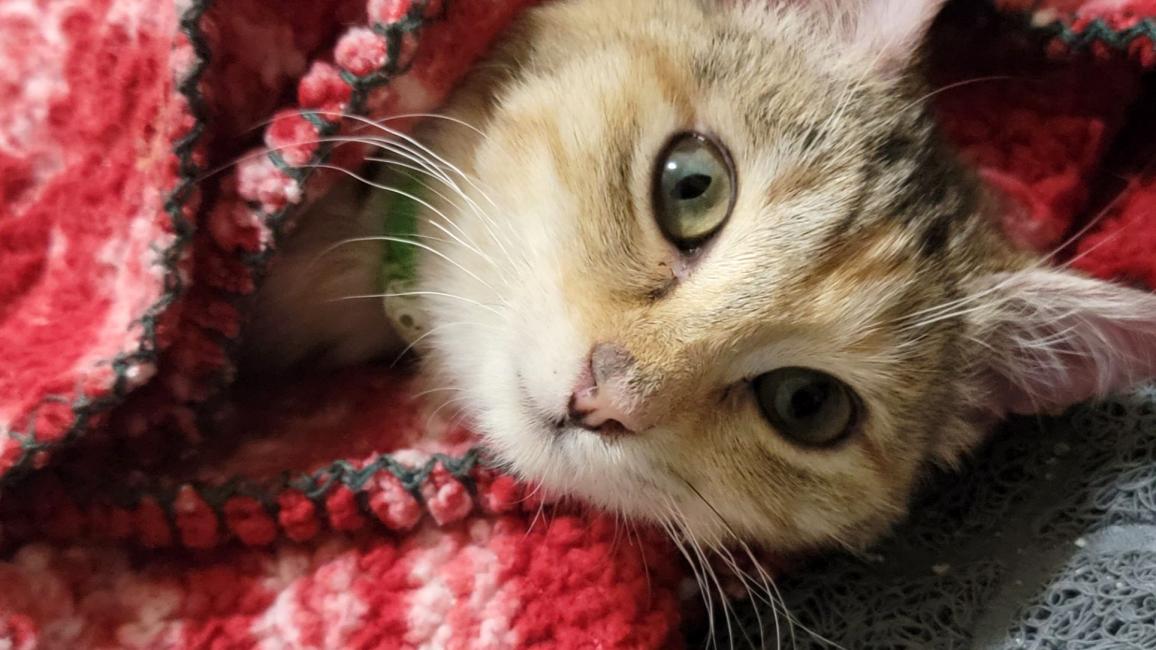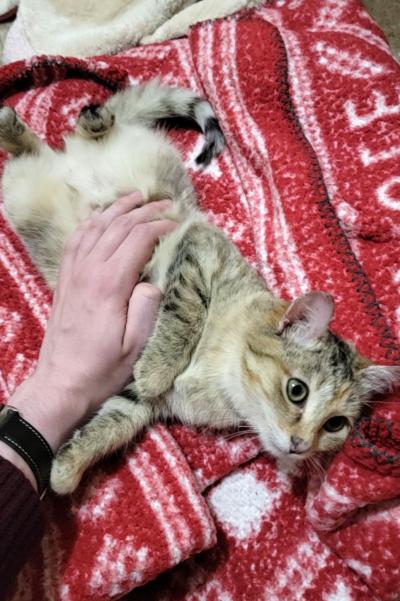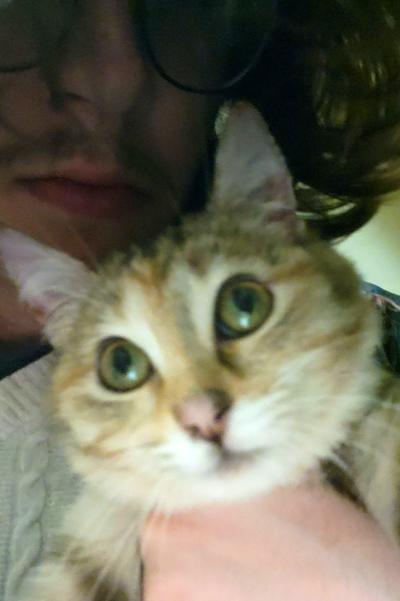Patience, love and sulfur baths help kitten with ringworm

Go ahead and call Chayce Lowham a cat dad. The way he sees it, it’s a title he earned on day one when he met Owl for the first time at Best Friends in Northwest Arkansas. That’s also the day he found out that she had ringworm but he took her home anyway.
“It’s not her fault she had ringworm. That was something I could fix. And she’d already been through so much,” says Chayce, referring to Owl’s first days at the lifesaving center after coming over from a shelter.
[Cat Ringworm: Diagnosis and Treatment]
Sarah Lorenzen, a Best Friends coordinator in Northwest Arkansas, remembers seeing Owl when she first arrived. “She seemed quiet and withdrawn,” she says. “But then, new surroundings can be stressful for cats.”
By the next morning, Owl had stopped eating. And then during a medical exam, she tested positive for panleukopenia (also called feline distemper), a serious upper respiratory disease.
In order for Owl to beat panleukopenia, she would need subcutaneous fluids, anti-nausea medications and other types of supportive care. And since it’s highly contagious, she’d also have to be isolated from other cats. But despite how bad she must have felt, Owl was a good patient. “She hardly complained, with all the poking and such,” says Sarah. “She did great.”
After a couple of weeks, Owl was finally on the mend and ready to be adopted.
Protector from day one
Although Owl quickly caught the attention of Chayce while he looked online for adoptable cats at Best Friends, Chayce wasn’t entirely sure the timing was right to welcome a new feline into his home. Moving to a new apartment was a distinct possibility, plus he was still grieving the loss of his kitten to feline infectious peritonitis (FIP). But upon seeing Owl’s photo, he says, “I just kept looking at that rotund little face and knew I had to meet her.”
A few days later, he visited the lifesaving center for a meet-and-greet, and as soon as Owl was brought into the room, she ran behind the chair he was sitting in. Chayce took it as a good sign. “I think she felt safe with me,” he says. “She saw me as a protector.”
But while Chayce was meeting with staff, a team member noticed something concerning, a small area of crusty skin on Owl’s ears, that appeared to be a telltale sign of ringworm, a highly contagious yet treatable fungal infection.
[Fast action saves two kittens on the brink]
Luckily, ever since she’d been treated for panleukopenia, Owl had stayed alone in a special area away from other cats, so there was little risk that she speared the infection. But ringworm can spread to people, too, so the team tested Owl while Chayce waited.
When the test came back positive, there were decisions to make: Owl could either stay at the center while being treated, or Chayce could treat her at home with support and guidance from the team. He figured there was no reason not to choose the latter, as long as he took the necessary precautions (covering his body, washing his clothes after holding Owl and keeping her in a separate room).

Loving care for a cat with ringworm
Chayce took Owl home and set up the bathroom where she would stay for the duration of her treatment. Since then, he carefully administers the veterinary treatments prescribed to clear up his new cat’s ringworm. There’s a topical solution that he applies to her skin once a day, and every four days, he gives Owl a lime sulfur bath, a messy process that requires patience, to say the least. Like most fellow felines, Owl does not like to get wet, let alone be lathered with a smelly solution that temporarily turns her fur yellow. But Chayce gets it. “She’s just not a bath woman,” he says. “It’s not easy giving her baths, but I have to remind myself that she’s not happy about it, either.”
[Getting past “the ringworm stigma”]
To make the baths more tolerable, he’s come up with a routine. With his girlfriend, Victoria, holding Owl, he spritzes the cat with warm water. Then, he gently places Owl in the sink and bathes her, making sure to give her plenty of breaks. Afterwards, he wraps her in a fresh towel that’s been warmed in the dryer and cuddles with her in the bathroom.
The treatment for ringworm can last anywhere from weeks to months, depending on how long it takes to kill the spores that ringworm leaves on skin and surfaces. In the meantime, Chayce checks in with the Best Friends team on a regular basis. He also takes her in for regular checkups so the veterinary team can see how well she’s progressing. So far, so good: Owl’s skin is looking much better and it appears she’s nearing the end of treatment.

A meow that melts hearts
Since the day Chayce adopted Owl, he’s been determined to not to let ringworm stand in the way of spending quality time (and plenty of it) with his girl. He diligently covers his arms and legs, puts on gloves and gets comfy on the bathroom floor, where they play until it’s time to snuggle. “She’s chatty,” says Chayce. “Once she gets to know you, you’re getting talked to. And she rumbles like a V-8 engine.”
In the morning, as soon as she hears Chayce outside the bathroom door, she’ll talk to him. It’s a meow that melts Chayce’s heart. “This has all been quite a process, but it’s worth it,” he says. “I just love her.”

A little extra time for a whole lot of love
Some pets may need some extra care, but just give them a chance and they will bring a whole lot of joy to your life, too.
Read more
There’s a fungus among us and it’s OK
Playful cat with special needs falls in love with his foster sibling